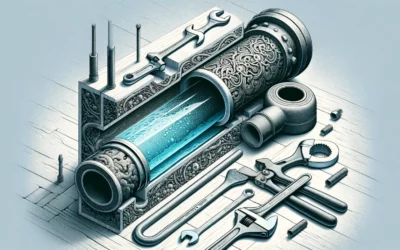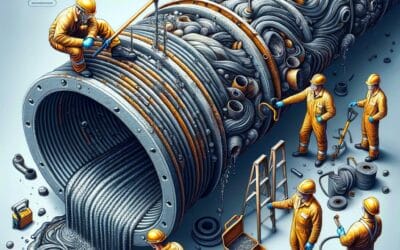Welcome to this expert’s guide on understanding your home’s sewer line. This informative and educational post is designed to provide you with reliable facts, practical insights, and expert opinion on everything you need to know about your home’s sewer line. From its basic function to the common issues you might encounter, this guide is made to help you comprehend and manage this essential component of your home system better. By gaining this understanding, you can prevent major issues, save on repair costs, and help increase the longevity of your sewer line. So, delve in and empower yourself with knowledge that is not just useful, but also easy to grasp.
Understanding Your Home’s Sewer Line: The Basics
Being a homeowner requires a basic understanding of its integral parts, one of which is the sewer line. Fundamentally, the sewer line or lateral is the central wastewater pipeline connecting your home’s plumbing to the municipal sewage system or your private septic tank. Everything from your sinks, tubs, toilets, and appliances heads down to this underground route. Generally made of PVC or cast-iron for durability, it slopes slightly downward from your house to facilitate gravity-assisted flow. However, problems can arise due to factors like tree root intrusion, line obstructions, or even wear and tear over time.
A few indicators of potential sewer line issues include:
- Foul odor: This is often the first sign of an issue – an unpleasant smell often resembling rotten eggs.
- Slow drainage: If water is slow to drain in multiple fixtures, the cause might lie in the sewer line.
- Gurgling noises: Listen to your toilets and drains – recurring gurgling sounds can indicate a blockage or a break in the line.
- Swampy yard: An unusually green patch of grass or standing water in your lawn is often a telltale sign of a leak in your sewer line.
Remember, while these signs may seem minor, they could potentially lead to bigger issues like foundational damage or hazardous health situations. Therefore, regular check-ups by a professional are always recommended. Educating yourself about your home’s plumbing system and maintaining it properly can save you a lot of stress, time, and money in the future.
Exploring the Function and Importance of Your Sewer Line
The sewer line of your home serves a critical role that often goes unnoticed until it becomes problematic. Acting as the main passageway for all wastewater leaving your home, the sewer line carries it all from the drains of your showers, sinks, washing machines, and toilets down to the municipal sewer system or septic field. A trouble-free sewer line ensures a healthy home environment, whilst a clogged or damaged line can lead to a series of unpleasant occurrences. With this in mind, it becomes crucial to understand the function of the sewer line and value its importance.
Please see the table below for some fundamental insights into your home sewer line:
| Part of Sewer Line | Function | Common Problems |
|---|---|---|
| Main Pipe | The biggest conduit for all wastewater. | Blockages due to grease or waste build-up. |
| Connectors | They tie household drains to the main line. | Leakages due to corrosion or cracks. |
| Vent Stacks | They allow sewer gases to escape and keep air pressure balanced. | Clogging due to leaves, bird nests, or other debris. |
| Traps | They trap water to prevent sewer gases from getting into the home. | Drying up or cracking. |
Exploring the functionalities of each section of your sewer line equips you with beneficial knowledge, helping you pinpoint issues when they arise. Regular maintenance of your sewer line can help you avoid severe issues such as sewage backup or flooding. Always be aware of the signs of potential sewer problems such as slow drains, foul odors, or unusual green patches in your lawn. This way, you will not only ensure your household’s comfort but also enhance your home’s overall functionality.
Common Problems with Home Sewer Lines: What to Look Out For
As a homeowner, there are numerous hidden processes that keep your household functional and comfortable. One important yet often overlooked aspect is your home’s sewer line. This vital part of your home’s plumbing system can cause significant stress when problems arise. Spotting these issues early on can save you from costly repairs and major inconveniences. In this section, we’ll discuss some of the common problems that homeowner’s might encounter and what you can do to spot them.
Blockages and Clogs: Excess build-up of waste, grease, or foreign materials can cause blockages in your sewer line. This usually manifests as slow drainage, frequent clogs, or water backing up out of drains.
- A common indicator is hearing a gurgling sound coming from your drains.
- If your toilets, sinks, or tubs are draining slowly even after preventative measures, you may have a sewer line blockage.
- Wastewater or sewage backup into your home is a clear sign of a significant blockage and requires immediate professional attention.
Tree Root Intrusion: Another commonly encountered problem is the penetration of tree roots into your sewer line. Over the years, roots from trees can crack, block, or even collapse your sewer line. Watch out for these warning signs.
- Unusually lush spots in your yard could suggest a leak from the sewer line.
- If your drains consistently produce a bad odor, it could mean roots have breached your sewer line.
- In extreme cases, you may notice sinkholes in your yard.
It’s worth noting that these symptoms aren’t always definitive proof of a sewer line problem. It’s always better to engage the services of a plumbing professional to do a thorough investigation and adequately diagnose any issues. Preventative maintenance would usually be more affordable and less of a headache compared to emergency repair.

Preventive Measures to Maintain a Healthy Sewer Line
In order to maintain a healthy sewer line, there are several important steps to take. This isn’t just a matter of tidying up occasionally; consistent preventative measures can save you significant time and money down the line. The first step in maintaining a healthy sewer line is to be mindful of what you’re putting down your drains. Unnaturally large items or substances that can build up over time, such as coffee grounds, cooking grease, and non-dissolvable items like sanitary products and baby wipes, can quickly clog your sewer line. In turn, this can cause the inefficient operation or even failure of your home’s entire drainage system.
- Regular cleaning: Clean your drains regularly using natural methods like hot water, vinegar, and baking soda.
- Professional Inspection: Have your sewer lines professionally inspected at least once a year.
- Tree management: Keep an eye on tree roots near your sewer line. These roots can grow into the line and cause blockages.
Additionally, using biodegradable toilet paper and installing hair catchers in your shower can preventissues that can potentially clog your sewer line. Now, let’s focus on understanding some of the preventative measures in more detail.
| Preventive Measures | Description |
|---|---|
| Regular Cleaning | Cleaning your drains at least once a month can prevent buildup and ensure efficient flow. |
| Professional Inspection | Inspections done by plumbing experts can pinpoint potential problems which can be addressed before they become costly issues. |
| Tree Management | By keeping tree roots trimmed and away from sewer lines, you can prevent damage caused by infiltrating roots. |
Remember, sometimes your home’s plumbing needs more than a DIY approach. Recognizing when it’s time to call in professional help is critical to maintaining a healthy sewer line. By regularly inspecting, cleaning, and caring for the trees in your yard, you can help prevent the issues that can lead to costly repairs or replacements.
Dealing with Sewer Line Issues: When to Call in the Pros
Understanding the issues that can arise in your home’s sewer line is essential. Complications in sewer lines are often not visible until the problem becomes severe, making it necessary to call in professionals. Diverse problems can occur in your home’s sewer line, including blockages, leaks, and pipe damage. For you as a homeowner, it can be difficult to identify these issues on time. Let’s have a look at some of the key signs your sewer line might be having issues:
- Consistent Drain Clogs: If you find your drains constantly blocking up, it might signify a sewer line problem.
- Unpleasant Odors: Foul smells coming from your drains or around your property can indicate a sewer line issue.
- Water Backup: If water backs up out of a drain or the toilet, it could be a reflection of a sewer line issue.
- Lush Patches of Grass: Lush green patches on your lawn may indicate a leak in your sewer line.
- Mold Problems: Moisture inside your home as a result of sewer line problems can eventually lead to mold growth.
It’s essential not to ignore these signs if you notice them. These issues do not resolve by themselves; they tend to escalate if left unresolved. It would be best if you called a professional immediately to ensure a thorough job is done. These experts possess the required training, experience, and endowment to efficiently handle such complications. When deciding when to call in a professional, keep the following things in mind:
| Situtation | When to Call a Professional |
|---|---|
| Consistent Drain Clogs | If draining solutions aren’t working anymore |
| Unpleasant Odors | When odor persists after cleaning |
| Water Backup | When backups happen multiple times |
| Lush Patches of Grass | If the location matches with the line location |
| Mold Problems | When interior mold growth seems unreasonable |
Dealing with sewer line issues might not be the most exciting part of homeownership, but it’s a crucial one. By staying attentive to these signs and knowing when to call in the pros, you can save yourself from a hefty potential disaster!

Sewer Line Repair and Replacement: A Cost and Complexity Comparison
When dealing with a home’s sewer line, two potential options typically arise: repair or replacement. The ideal choice among these options rent largely on the cost and complexity involved in the process. It’s essential for every homeowner to understand these factors to make an informed decision. Repair: This is preferential when the line is damaged but not severely so. It involves identifying the issue and resolving it without an overhaul of the system. Cost varies depending on the method chosen. For example, pipe relining can run between $100 to $200 per foot, while pipe bursting, being a bit more complicated, could cost between $100 and $200 per foot. Replacement: This is usually the last resort when the damage is severe and requires the existing pipeline to be completely replaced. The project’s complexity is high due to the work involved – digging up the yard, removing the old pipe, and installing the new one. The cost is dependent on the length and depth of the pipe and the type of pipe being installed. As a rough estimate, expect to pay between $1,500 and $15,000 for a full sewer line replacement.
| Method | Complexity Level | Estimated Cost |
|---|---|---|
| Repair (Pipe Relining) | Medium | $100-$200 per foot |
| Repair (Pipe Bursting) | High | $200-$500 per foot |
| Replacement | Very High | $1,500-$15,000 total |
Remember, every case is unique, and these cost estimates can widely vary depending on the situation. It’s always advisable to consult with an expert and get a detailed estimate before settling on a decision.
Future Outlook
To wrap up, understanding your home’s sewer line is not as intimidating as it may initially seem. With an awareness of the intricacies involved, the type of pipes used, the general layout, and common problems, you hold the power to potentially avoid costly repairs and inconvenient problems. In the event of a sewer line issue that surpasses your abilities, don’t hesitate to reach out to a professional — their expertise can provide invaluable help. Remember, as a homeowner, your most potent tool is knowledge. Your awareness and understanding are essential in maintaining the efficiency of your residential sewer system. Conservation and correct use of your home’s plumbing will not only save you money in the long run but also contribute to a healthier and more sustainable environment. In conclusion, your home’s sewer line isn’t a mystery – it’s just another aspect of your home needing your care and maintainance. Stay vigilant, stay informed, and remember, an efficiently running sewer system is a key component to a happy home. Here’s to a better comprehension of your home’s plumbing, and to the peace of mind that comes with it. Happy Homeownership!









